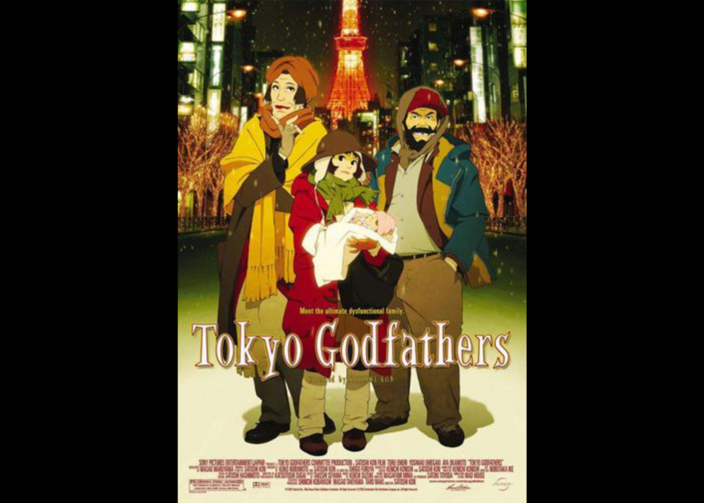The Catholic Movie Club is a short weekly essay pulling out spiritual themes in our favorite films. You can discuss the movies with other readers in the comments on this page or in our Facebook group. Find past Catholic Movie Club selections here. For the month of December, Catholic Movie Club will cover more recent—and less well-known—Christmas films, to give you some new additions to your holiday canon.
Homelessness. Mob hits. Alcoholism. Regrets. Multiple suicide attempts. A newborn baby abandoned in the trash. None of this sounds like it belongs in a funny, heartwarming, animated Christmas movie.
But that’s only if you’ve never seen “Tokyo Godfathers.”
Released in 2003, “Tokyo Godfathers” is definitely the most unconventional Christmas movie I’m covering this month.
Released in 2003, directed by the groundbreaking (and, sadly, departed) director Satoshi Kon, with a screenplay by Kon and Keiko Nobumoto, “Tokyo Godfathers” is definitely the most unconventional Christmas movie I’m covering this month. But it is a Christmas movie, full of kindness, family and even a few miracles.
The film opens on Christmas Eve in Tokyo, when the aforementioned baby is discovered by a loose “family” of people living on the streets. As far as Magi go, they are pretty unlikely. Gin (Tooru Emori) is a hard-drinking, temperamental middle-aged man troubled by his failures; Hana (Yoshiaki Umegaki) is a theatrical trans woman whose smile covers secret grief; and Miyuki (Aya Okamoto) is a surly teenage runaway. Hana names the baby Kiyoko (“pure child”) and believes she is a sign from God. She convinces the others that they should find Kiyoko’s mother, launching a quest across Tokyo that takes them to yakuza weddings, drag bars and in and out of emergency rooms. Guided by scant clues and coincidences that might be divine intervention, they grow closer to each other and discover surprising opportunities for reconciliation with their troubled pasts.
“Tokyo Godfathers” is certainly grittier than your typical holiday film, marked by cynical and sometimes risqué humor (some of which hasn’t aged well; the same applies to some of Hana’s treatment as a trans woman, although she is also one of the most heroic and pure-hearted characters in the film). It offers a distinctly—and refreshingly— unromantic view of homelessness. The protagonists aren’t crude caricatures or maudlin pity-objects, but multidimensional human beings—deeply flawed, but capable of great grace and kindness. At the same time, the film doesn’t ignore the difficulty and danger of homelessness, or shy away from indicting a society that sees human beings as disposable. The fact that our heroes are “the lowest of the low,” in the eyes of polite society, is entirely the point. This is a Christmas movie about the people Christ actually identified himself with.
From the very first frame, the film acknowledges the gulf between our sanitized view of the sacred and where it’s actually found: a close-up of a smiling, blonde and entirely artificial Baby Jesus in a Nativity pageant that Gin and Hana have to watch before receiving food at a Christian mission. Baby Kiyoko, by contrast, is a real baby who cries and poops and needs to be fed. But small miracles accrue around her, the divine coming into the world once again through an infant with nowhere to lay her head. It’s in the dirt and the mess of real life that we truly encounter God.
This is the scandal and the wonder of the Incarnation: that God comes to us in fragile flesh and bone and blood, surrounded by garbage and danger, embraced only by those no one else would welcome into their homes. Emmanuel, God-with-us, isn’t just a nickname. It’s a compass, pointing the way to the sacred in the flawed and finite world around us. If “Tokyo Godfathers” feels rougher around the edges than most Christmas movies, maybe it’s because it’s one of the few that takes the underlying message of the Incarnation seriously.
(I should note, for the sake of clarity, that Kon wasn’t a Christian filmmaker and “Tokyo Godfathers”—while making great use of Christian motifs—isn’t a Christian film. The film is full of allusions to Buddhism and Shintoism, too, and Hana’s faith seems more nebulous than any particular denomination. It’s not strictly a religious film, but a deeply spiritual one.)
“Tokyo Godfathers” relies on the sort of coincidences that feel profound in real life but often come across as contrived on film. But if there’s any genre where that feels appropriate, I would argue it’s the Christmas movie. At Christmas we celebrate the birth of the one who makes all things new. We raise up our hopes that we can be made new, that we can finally find the grace or peace that’s eluded us. Each of the protagonists is running away from something, and none of them believe they can ever go home again. But this unlikely miracle—a baby in a dumpster—reveals to each of them the possibility of new life, and the scandalous, spectacular hope that no one is too far gone.
As we celebrate Christmas this year, let’s pray for the grace to see everything new in the light of Christ’s birth. And let’s also remember, as we always should, all of our brothers and sisters who still have no safe place to lay their heads. Today, the manger might look like an overpass, a vacant doorway, a tent of blue tarp stretched between branches on a hillside along the highway. Christ is there, waiting for us to find our way to him.
“Tokyo Godfathers” is free to stream with ads on Roku and Tubi, and is streaming on the Hoopla app, which may be available through your local library.








